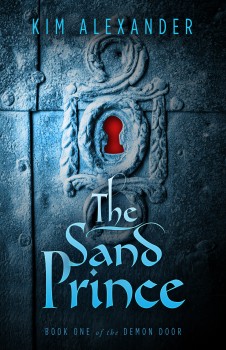The Sand Prince by Kim Alexander
Kim Alexander’s debut fantasy-thriller THE SAND PRINCE, the first installment in the Demon Door series, introduces readers to not one, but two new worlds, and a cast of characters torn between those universes where demons, magic, and high adventure are part of the landscape.
On the war-ravaged demon world called Eriis, Hellne, a strong young demon queen, struggles to keep her people alive. On the world of Mistra, demons have become whispered myths and a handful of people guard The Door, an opening between the two worlds.
Readers know, of course, that the status quo can’t be maintained in any novel, so both worlds are destined for upheaval. That the door is destined to be opened, and the two worlds are destined to collide.
In THE SAND PRINCE, that comes when Rhuun, a demon prince of Erris, uncovers a book with secrets about another world. When he’s forced through The Door, he finds more than he expects on Mistra, including a fierce and headstrong human heroine named Lelet. And in Mistra, the people soon learn demons are more than myths.
Alexander, who grew up in the wilds of Long Island, NY, crafted those worlds after a stint as co-programmer of Sirius XM Book Radio, where she interviewed some of her favorite writers, including Anne Rice, George R.R. Martin, Neil Gaiman, Stephen King and Margaret Atwood, among hundreds more.
She currently lives with “two cats, an angry fish,” and her “extremely patient husband” in Washington, D.C., close enough to the National Zoo “to hear the lions and the monkeys.” At least she hopes that’s what those noises are.
This month, she fields a few questions for The Big Thrill about her latest release.
THE SAND PRINCE has a large cast of characters. Tell us a little about Lelet and Rhuun and how they developed for you. When did they start to breathe and live in your imagination?
They came to me in a vision. No, they really did! I find I get most of my ideas in that space where I’m not quite asleep, and I got a very clear image of two people sitting around a campfire. The woman was wearing a party dress and had white hair, and the man had red eyes. I knew he had kidnapped her, but also that she wasn’t afraid of him. Finding out who they were and how they got there began the process of writing this book. Funnily, Lelet, my human heroine, is closest to me in terms of life experience, and she was the hardest character to pin down. Depressed demon—piece of cake. Human woman—how would I know anything about that?
And what about Hellne and Malloy?
In this case I was working backwards and filling in the lives of my main characters. I had to understand Eriis, the world Rhuun grew up in, and so I gave him parents. In the first draft, Queen Hellne was far less sympathetic and Malloy, her human lover, was more devious. She certainly has her failings—she’s not the world’s greatest mom—but she kept her people alive through a terrible crisis. Malloy, meanwhile, dreamed of being a famous novelist, and it’s his book, The Claiming of the Duke, which winds up re-connecting the two worlds.
It’s clear a great deal of world building was required for THE SAND PRINCE— really, two worlds. What went into devising the backdrop for your novel and the demon race? What about the door between worlds that gives the series its name?
Because the demon world was so alien, I wanted the humans to live in a place that was more relatable. I put them in a city called Mistra, very much like my home, Washington DC, at the turn of the last century.
The demon kingdom of Eriis is a war-torn desert city. One of the first things I knew about Eriis was it was a bit of a reverse-Oz, in that it’s the place with magic, but it’s monochromatic (everything is covered with sand and dust) and pretty unpleasant. That said, it’s still home to a lot of people (well, demons) who live there and have families. I thought a lot about the psychological adjustments you make to convince yourself everything is fine, when it’s clearly not.
As far as The Door, it connects the demon and human worlds. Relations between them at the beginning of the book are strained, as both societies have things the other wants, and there’s a huge lack of trust. The Veil is the Anti-Welcome mat, and you don’t want to get stuck there.
What do you think is essential to make a thriller work for readers with a new world or world unlike our own?
I concentrated on the little rituals that make up a society. The reader has to first understand what people are expected to do in order to appreciate the stakes when they don’t do it. The demons of Eriis are living in the partially rebuilt ruins of their city. They cling to the artifice of the past, and so they are much more formal than my human characters in their interactions. This is particularly true of the characters I’m introducing you to, who are either in the royal family or closely associated to them. It’s when people bend or break the rules you get the drama.
How long did the creation of this work take? You mention on your blog that you did a bit of restructuring. Was part of that geared toward ramping up suspense? How did your relationship with your editor affect that process?
This book took about two years top to bottom. And we did a big re-edit in the spring, and that absolutely went towards ramping up the suspense. My editor, Carly Bornstein, took one look and understood what I was going for, and part of that was as simple as re-organizing the chapters (among many other things.) She’s a gift!
It’s also clear in your work that you have a real love for epic fantasy. What was the first book that really snared you and piqued your imagination in the fantasy realm?
I’ve been re-reading The Once and Future King (by T.H. White), which I hadn’t read for many years, and I think I didn’t realize how much of it I absorbed. I’d forgotten that Lancelot is a very ugly child. Rhuun, my hero, is a very ugly demon (but an extremely nice looking human.)
And Dune, which is so meticulous and elegant in its world building. I loved Herbert’s including epigraphs at the beginning of chapters, because they gave us a glimpse at the scope of his universe. My epigraphs are less serious, though; they are excerpts from Rhuun’s favorite book, that romance novel I mentioned earlier.
Are there other major influences or who are some other favorite authors, and what did you learn from them?
China Miéville for audacity. Anne Rice for seductive, gorgeous language. JT Ellison for character building and showing me that writing can be a job, not a hobby. Tasha Alexander for life travel goals. (She’s always somewhere I want to be.) And Stephen King for his comment that fear is the enemy of great writing.
Since this is a debut novel, tell us a little about your writing process? How do you handle your writing schedule, and do you have any magical devices that help you keep the words flowing?
My magical device is that my husband is currently supporting my writing—guilt is an excellent motivator!
Maybe from my past life as a broadcaster, I am quite disciplined. If the record ended, you’d better have something teed up! It was like having a deadline every three minutes. So I got in the habit of turning off my phone and writing every day. Sometimes more, sometimes less, but something. You can’t fix what you don’t write.
Like many writers, cats are important to you. How do your cats factor into your writing process?
Onion is a great source of inspiration, as readers of my blog might already know. He and Rhuun have some things in common: they are very large for their species, and they both have long, silky black hair. Onion, however, does not struggle with social anxiety or a drinking problem. On the other hand, at fifteen plus pounds, if he sits in my lap, he dislocates both my hips. So lap sitting is reserved for my other cat, Leeloo, who is a petite flower, and her job is to hold me in place.
The book ends with a promise of more to come. What’s ahead in the universe of THE SAND PRINCE?
Glad you asked, as I am wrapping up book two right now. In a way, it’s been easier. The characters have all been introduced, all the exposition has been…exposited. But it’s also more difficult because the cast is so large—I have about forty named characters—and I have to keep track of where everybody is and who did what to whom.
Without giving too much away, in the first book, Rhuun rescues Lelet from some pretty dire circumstances. (It might be noted it was his fault to begin with, but bygones.) In the second book she gets to return the favor.
I’ve found the more I write in these two worlds, the more I have to say, and the more I learn. Plus, someone gets a pet cat in book three!
THE SAND KINGS is currently on sale and the demon door is ready for readers to open it and get a look beyond.
*****
 Kim Alexander grew up in the wilds of Long Island, NY and slowly drifted south until she reached Key West. After spending ten years working as a disc jockey in the Keys, she moved to Washington DC, where she reported the traffic and spun the Oldies. After a career upgrade, she became the co-programmer of Sirius XM Book Radio, which gave her the opportunity to interview some of her writing heroes, including Anne Rice, George RR Martin, Neil Gaiman, Stephen King and Margaret Atwood, among many hundreds of others. She began writing when she ran out of authors to interview (and they pulled the plug on her channel.)
Kim Alexander grew up in the wilds of Long Island, NY and slowly drifted south until she reached Key West. After spending ten years working as a disc jockey in the Keys, she moved to Washington DC, where she reported the traffic and spun the Oldies. After a career upgrade, she became the co-programmer of Sirius XM Book Radio, which gave her the opportunity to interview some of her writing heroes, including Anne Rice, George RR Martin, Neil Gaiman, Stephen King and Margaret Atwood, among many hundreds of others. She began writing when she ran out of authors to interview (and they pulled the plug on her channel.)
She currently lives with two cats, an angry fish, and her extremely patient husband close enough to the National Zoo to hear the lions and the monkeys, at least she hopes that’s what those noises are.
To learn more about Kim, please visit her website.
- Cthulhu Blues by Douglas Wynne - November 30, 2017
- Down to No Good by Earl Javorsky - November 30, 2017
- Storm Wolf by Stephen Morris - October 31, 2016

